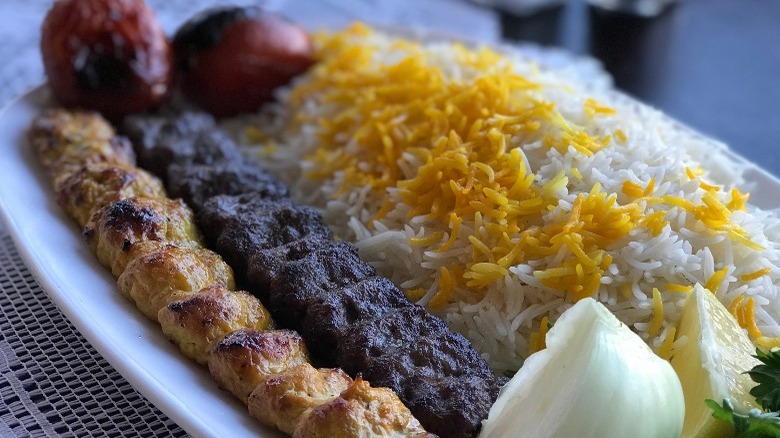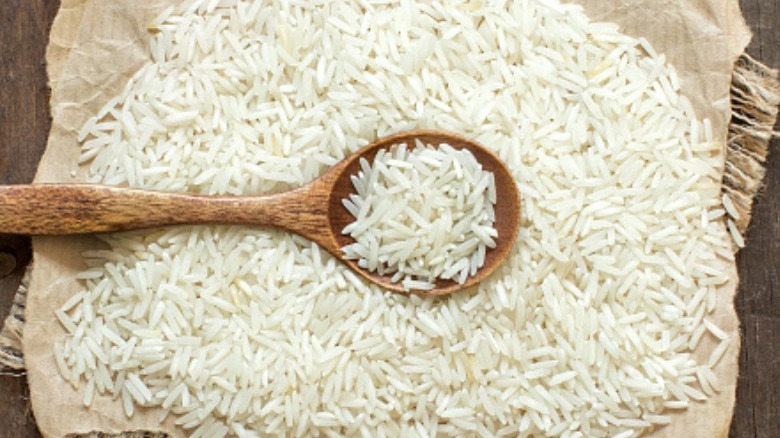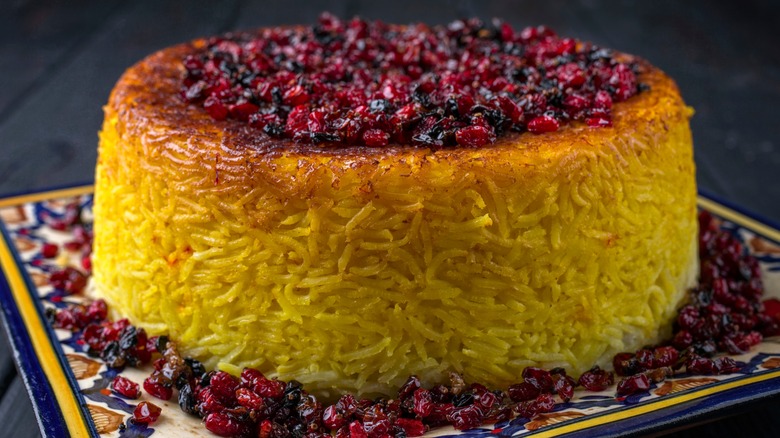Chelow With Tahdig: The Mouthwatering Iranian Rice That Takes Time To Master
We may receive a commission on purchases made from links.
If you've ever been to a Persian or Iranian restaurant, you've probably had chelow or chelo which means "plain steamed rice" in Farsi, via The Splendid Table. It's that lovely white rice topped with a bit of saffron-colored rice and served alongside dishes such as kebab, sultani, koobideh, and khoresh (fragrant stews) among others (via Culture Trip). At first, when this unassuming dish of yellowy-flecked rice is set before you, you might think, "It's rice, right? There are only so many variations." But that's before you've tasted it. After you've tried it, you'll find there's a tantalizing bounty of textures, flavors, and savory comfort awaiting you.
While chelow is often served with kebabs, roasted tomato, and raw onion, it's also served on its own for weddings and other special occasions. But, in these cases, it is served with a delicious bottom crust called tahdig. The standalone dish has both the fluffy white rice component, as well as the golden, saffron-scented, and butter-laden crust that makes it such a standout for celebrations. But because these components can be served separately, you'll find recipes interchangeably calling it everything from chelow to tahdig, and Persian or Iranian rice, to chelo ba tahdig, as author and food blogger, Naz Deravian calls it in her cookbook aptly titled, "Bottom Of The Pot: Persian Recipes and Stories." But where did this dish of many names come from?
Origins of chelow with tahdig
As Persian Tours notes, rice is invaluable to Iranian cuisine. Rice came to Iran via southeast Asia and India. At first, it was only for the elite — a favorite of the Safavid family empire's household — but between the 7th and 13th centuries, rice started to be cultivated in the region and its popularity became widespread. Nowadays, a majority of the long-grain rice grown in Iran comes from the provinces of Gilan and Mazandaran in the Caspian Sea region and in the Alborz mountains. Culture Trip reports that Persian Qajar King, Naser al-Din Shah, who was a big fan of chelow kebab from the Caucasus region, helped grow the popularity of the dish, which led it to becoming the national dish of Iran.
But chelow and tahdig are not just the result of Iranian farmers growing long-grain rice in the region. They're the result of a variety of things like the ingredients, including the types of rice produced, the firmly held belief of the Iranian people that aged rice is better (most prefer at least one year of aging), and the time-honored cooking traditions and techniques that have been passed down through generations, per Persian Tours.
Persian rice ingredients
Iranian cookbook author Naz Deravian says to make perfect chelow with golden tahdig, "Every grain of rice should be separate, long, individual, fluffy — and shine on its own. No clumps. No sticking together. Every grain is a jewel." This requires starting with the right ingredients. Rice is the star here and therefore important, but brand choice appears to be personal. While you can use any long-grain basmati rice you like, aged rice is best. Deravian uses the Lal Qilla brand, while VICE Media's Culinary Director, Farideh Sadeghin, used Royal brand basmati in a Munchies video on YouTube (both of which are aged two full years and are available to order on Amazon).
Once you've chosen your rice, the other ingredients are quite simple, Deravian says: water, butter, saffron, a neutral cooking oil, yogurt, and lemony sumac for sprinkling on top as desired. If the price of saffron puts it out of reach for you, Sadeghin suggests turmeric's zing to mimic the dish's golden hue, while Cook's Illustrated recommends the earthy taste of cumin as a substitution. Master the cooking technique and your ingredient list can grow, as you branch out to sister dishes like tachin (a chicken-filled version of chelow) or zereshk polo with barberry (Persian rice with tahdig, chicken, and barberries), which Deravian told Sunset Magazine she serves for the winter solstice celebration of Yalda.
How to make chelow with tahdig
Really good chelow tahdig is the perfect contrast of textures: fluffy-light rice juxtaposed with the buttery browned layer of crust. But achieving this from traditional recipes can take more than a day's worth of prep. Thankfully, Cook's Illustrated decided to "streamline" the process without losing any of the taste or texture that make this dish such a comforting delight. It starts with a quick rinse of the rice before a 15-minute hot soak in salted water (down from the traditional 24 hours). Then parboil it for three to five minutes, straining and rinsing again.
Next, combine some of the rice with yogurt, oil, and saffron water before packing it in tight to a well-greased Dutch oven (to evenly brown and crisp the tahdig). Then add in the remaining grains, piling them into a mound to direct the steam upward. Next, wrap your lid with a thin, flour sack towel to absorb excess moisture. Once removed from the oven, place a damp towel beneath the dutch oven to rapidly cool the bottom of the pot for a quick and clean release of the crust.
Finally, turn the rice out onto a serving platter and top it with a sprinkling of sumac or a chiffonade of parsley or mint for a little added color but as Naz Deravian notes, "The tahdig should be eaten right away. It does not keep. And frankly I've never had any tahdig left over."



